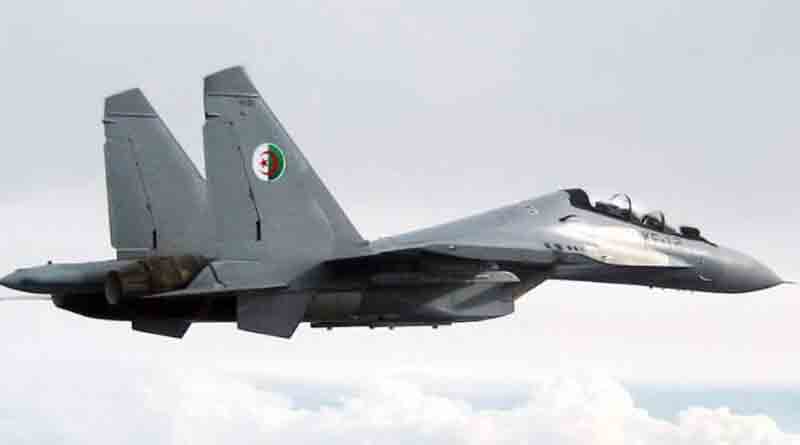An Algerian Air Force Su-30 fighter jet crashed in the southwestern region of Algeria, close to the town of Adrar, leading to the pilot’s death, as reported by various sources from the North African country. The incident occurred shortly after takeoff, with preliminary reports indicating that while the operator successfully ejected, the pilot did not survive.
The exact cause of the crash remains unknown, and officials have not yet issued a formal statement detailing the circumstances. This incident has raised concerns regarding Algeria’s military aviation capabilities, prompting inquiries into the safety and maintenance of its aircraft.
The crash happened on March 19, 2025, in a remote area located about 1,000 miles southwest of Algiers. Local reports, including posts on X and information from the Algerian defense news outlet MenaDefense, confirm that the aircraft involved was a Sukhoi Su-30, a twin-engine, multi-role fighter jet of Russian design that is extensively utilized by the Algerian military.
Eyewitnesses referenced in early social media posts reported hearing a loud explosion followed by smoke billowing from the desert, although the Algerian Ministry of Defense has not officially verified these claims.
The timing of the crash, occurring shortly after the jet’s departure from an airbase, raises the possibility of mechanical failure or human error, though such speculation remains unconfirmed pending further investigation.
Algeria possesses one of the largest fleets of Su-30 aircraft in Africa, with approximately 70 units in operation, according to the Stockholm International Peace Research Institute (SIPRI). The nation has significantly depended on Russian-made equipment to enhance its air force, a collaboration that has been in place for many years.
The Su-30, recognized for its sophisticated avionics and adaptability in combat, plays a vital role in Algeria’s defense strategy, especially in safeguarding its extensive borders and addressing regional threats. Nevertheless, this is not the first instance of the Algerian military encountering aviation-related accidents.
In the last ten years, multiple incidents involving both fixed-wing aircraft and helicopters have led to loss of life, raising concerns about training standards and the reliability of equipment.
Aviation specialists who are knowledgeable about the Su-30’s operational background point out that, despite the jet’s impressive capabilities, its effectiveness relies heavily on thorough maintenance and proficient operation. “The Su-30 is an advanced platform, but like any intricate machinery, it can be susceptible to technical problems if not adequately maintained,” remarked Mark Schwartz, a former U.S. Air Force officer and military aviation consultant in Washington, D.C.
Schwartz stressed that without access to crash data, it is too early to assign a specific cause to the incident. “The cause could range from engine malfunction to navigation mistakes. Investigations usually take weeks or even months to draw conclusions,” he noted. His remarks highlight a general caution among analysts against making hasty judgments in the absence of solid evidence.
The Algerian government has yet to reveal the names of the crew members involved in the incident or confirm if a second occupant survived the ejection, as some initial reports indicated.
MenaDefense, a reputable source on Algerian military issues, reported that the operator who ejected sustained injuries but is alive, although this information is pending official verification.
Such a lack of transparency is typical for Algeria, where military affairs are often kept under wraps. In previous incidents, like the 2018 crash of an Il-76 transport plane that resulted in 257 fatalities near Algiers, initial silence from officials was eventually followed by limited updates after public pressure increased.
For the United States, which has a complex relationship with Algeria, the crash has potential ramifications that extend beyond the immediate loss of life. Algeria’s military capabilities and its significant role in maintaining stability in North Africa are of interest to American policymakers.
The U.S. has collaborated with Algeria on counterterrorism initiatives, particularly in the fight against extremist groups such as Al-Qaeda in the Islamic Maghreb, which operate in the Sahel region near Adrar.
“Any decline in Algeria’s operational capabilities could impact its ability to project power and secure its borders,” stated Emily Carter, a North Africa analyst at the Center for Strategic and International Studies in Washington. She emphasized that while a single crash does not indicate a systemic failure, repeated incidents could strain Algeria’s resources and tarnish its reputation.
The Su-30 has its roots in the Soviet era, entering service in the 1990s as an advancement of the Su-27 Flanker. Designed for air superiority and ground attack missions, it has a range exceeding 1,800 miles and can carry a diverse array of munitions, making it a formidable asset.
Algeria began its acquisition of aircraft in the mid-2000s through a series of contracts with Russia’s Rosoboronexport, as part of a larger effort to modernize its military following the civil conflicts of the 1990s. By 2019, SIPRI estimated that Algeria had invested billions in Russian military equipment, solidifying its position as one of Moscow’s primary clients in the region.
However, this partnership has faced its share of difficulties, including delivery delays and concerns regarding the quality of the equipment, which have occasionally raised alarms within defense circles.
To provide context for the Adrar crash, comparisons can be drawn to similar incidents in other locations. In 2021, a Russian Su-30 experienced a crash during a training exercise in Siberia, with both pilots managing to eject safely. Investigators later determined that a bird strike was the cause of that incident, highlighting a common risk in aviation.
It remains unclear whether environmental factors contributed to the situation in Algeria, although the desert environment near Adrar, characterized by sandstorms and extreme temperatures, could present specific challenges. “Dust ingestion can severely impact jet engines,” noted Schwartz, an aviation consultant. “This is just one of many factors that investigators are likely to consider.” He emphasized that while modern aircraft are designed with protective measures, no system is entirely infallible.
In Algeria, public response has been relatively subdued, primarily due to restricted press freedoms and the sensitive nature of military issues. Nevertheless, social media platforms like X have seen an increase in user posts speculating about the cause of the crash and expressing condolences for the pilot’s death.
One individual, commenting in Arabic, referred to it as “a tragic loss for our forces,” while another raised questions about the age of the aircraft involved. Without official information regarding the specific jet’s service record, such discussions remain largely anecdotal. In the United States, the incident has received minimal mainstream coverage, overshadowed by domestic news, although defense blogs and specialized outlets have started to report on it.
The crash has broader implications for Algeria’s position in the region. Its neighbor, Morocco, which has a strained rivalry with Algeria intensified by the Western Sahara conflict, operates a smaller yet modern air force that includes American-made F-16s.
Analysts indicate that any perceived weakness in Algeria’s military could alter the power dynamics in North Africa, although a single incident is unlikely to significantly change the existing balance. “At this point, it’s more about perception than reality,” noted analyst Carter. “If such incidents accumulate, it could encourage Morocco or others to challenge Algeria’s determination.”
Investigations into military aviation accidents generally involve several stages, including wreckage recovery and analysis of flight data recorders, commonly known as black boxes. In Algeria’s situation, collaboration with Russian experts is likely, given the Su-30’s origins.
Previous investigations, like the 2014 crash of a C-130 Hercules that resulted in 77 fatalities, have taken months to produce results, with some findings remaining confidential. The Adrar incident may follow a similar path, leaving observers to piece together the events from incomplete reports in the meantime.
As the situation stabilizes in southwestern Algeria, the loss of the Su-30 and its pilot highlights the inherent dangers of military aviation, even for a country with a strong defense system. In the coming weeks, more information is expected to emerge as investigators analyze the evidence and officials determine the extent of information to release.
Currently, the crash stands as a poignant reminder of the human and financial toll associated with sustaining a contemporary air force, as the complete narrative remains to be uncovered from the desert sands.
Discover more from Defence Talks | Defense News Hub, Military Updates, Security Insights
Subscribe to get the latest posts sent to your email.





